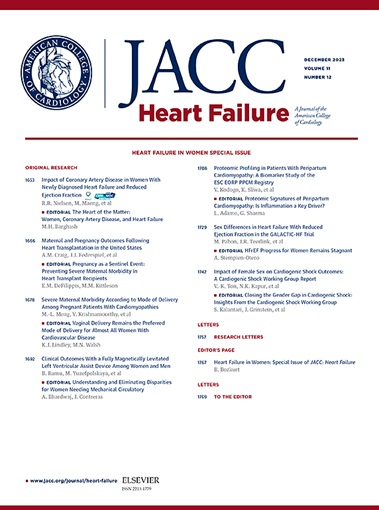Differential Associations of Cardiac, Pulmonary, Arterial, and Muscle Physiological Parameters and Biomarkers With the Incidence of HFpEF and HFrEF
IF 10.3
1区 医学
Q1 CARDIAC & CARDIOVASCULAR SYSTEMS
引用次数: 0
Abstract
Background
Postulated differences in heart failure with preserved ejection fraction (HFpEF) compared with heart failure with reduced ejection fraction (HFrEF) include greater contributions of noncardiac dysfunction to HFpEF.
Objectives
This study aims to evaluate associations of cardiac and noncardiac physiological measures with prevalent and incident HFpEF and HFrEF.
Methods
Among 5,484 Atherosclerosis Risk in Communities study participants attending the fifth visit (2011-2013), this study assessed associations of cardiac structure and function by echocardiogram, pulmonary function by spirometry, arterial stiffness by pulse wave velocity, muscle strength by handgrip, fat mass by bioimpedance, inflammation by plasma biomarkers, and renal function with prevalent and incident adjudicated HFpEF (ejection fraction [EF] ≥50%) and HFrEF (EF <50%) by using adjusted logistic and Cox models.
Results
Mean age was 75 ± 5 years, 59% were women, left ventricular (LV) EF was 65% ± 7%, 246 patients had prevalent HFpEF, and 81 patients had prevalent HFrEF. Worse LV and right ventricular systolic function and larger LV size were associated more strongly with prevalent HFrEF; a higher body mass index (BMI) was associated more strongly with prevalent HFpEF. Among heart failure–free participants, 220 incident HFpEF and 187 HFrEF events occurred over a median 7 years (range: 6-8 years) of follow-up. Worse LV systolic function and larger LV size were more strongly associated with incident HFrEF, whereas higher pulmonary artery systolic pressure demonstrated a greater association with incident HFpEF. Most noncardiac dysfunctions, including greater BMI, fat mass, and systemic inflammation, showed similar magnitudes of association with incident HFpEF and HFrEF.
Conclusions
Among older adults, subclinical LV systolic dysfunction and remodeling differentially predicted the risk of incident HFrEF, whereas diastolic and most noncardiac dysfunctions were associated similarly with both incident HFpEF and HFrEF.
心脏、肺、动脉和肌肉生理参数和生物标志物与HFpEF和HFrEF发病率的差异关联
背景:与射血分数降低的心力衰竭(HFrEF)相比,保留射血分数的心力衰竭(HFpEF)的假设差异包括非心功能障碍对HFpEF的更大贡献。目的本研究旨在评估心脏和非心脏生理指标与HFpEF和HFrEF发病率和发生率的关系。方法在参加第五次随访的5484名社区动脉粥样硬化风险研究参与者中(2011-2013),本研究通过超声心动图评估心脏结构和功能的相关性,通过肺活量计评估肺功能,通过脉搏波速度评估动脉僵硬度,通过握力评估肌肉力量,通过生物阻抗评估脂肪量,通过血浆生物标志物评估炎症。使用调整后的logistic和Cox模型,判定HFpEF(射血分数[EF]≥50%)和HFrEF (EF <50%)的流行和事件。结果平均年龄75±5岁,女性占59%,左室EF 65%±7%,有HFpEF 246例,有HFrEF 81例。较差的左室和右室收缩功能以及较大的左室尺寸与HFrEF的发生率相关性更强;较高的身体质量指数(BMI)与HFpEF的患病率相关性更强。在无心力衰竭的参与者中,在中位7年(6-8年)的随访期间,发生了220例HFpEF事件和187例HFrEF事件。较差的左室收缩功能和较大的左室尺寸与HFrEF的发生有更强的相关性,而较高的肺动脉收缩压与HFpEF的发生有更大的相关性。大多数非心脏功能障碍,包括较高的BMI、脂肪量和全身性炎症,与HFpEF和HFrEF事件的关联程度相似。结论:在老年人中,亚临床左室收缩功能障碍和重构预测HFrEF发生的风险存在差异,而舒张功能和大多数非心脏功能障碍与HFpEF和HFrEF的发生相似。
本文章由计算机程序翻译,如有差异,请以英文原文为准。
求助全文
约1分钟内获得全文
求助全文
来源期刊

JACC. Heart failure
CARDIAC & CARDIOVASCULAR SYSTEMS-
CiteScore
21.20
自引率
2.30%
发文量
164
期刊介绍:
JACC: Heart Failure publishes crucial findings on the pathophysiology, diagnosis, treatment, and care of heart failure patients. The goal is to enhance understanding through timely scientific communication on disease, clinical trials, outcomes, and therapeutic advances. The Journal fosters interdisciplinary connections with neuroscience, pulmonary medicine, nephrology, electrophysiology, and surgery related to heart failure. It also covers articles on pharmacogenetics, biomarkers, and metabolomics.
 求助内容:
求助内容: 应助结果提醒方式:
应助结果提醒方式:


